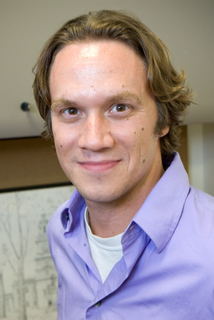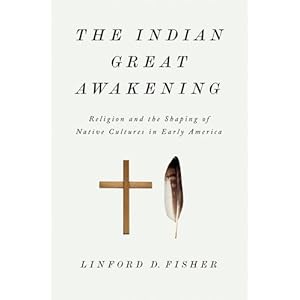The Indian Great Awakening: Part 2 of 4
by Paul Harvey
I'm delighted to present Part I of our three-part interview with Linford Fisher, Professor of History at Brown Univ. and author of The Indian Great Awakening: Religion and the Shaping of Native Cultures in Early America. A quick note: Question # 3 below, and Lin's answer, are copied directly from the previous interview with Lin conducted by Ed Blum and Kevin Schultz at the Teaching U.S. History 2.0 blog.
You can go here for the entire 4-part series in one easy reading series. Or, in separate parts: Part 1 is here, Part II here, and Part III here.

Although I love Worlds of Wonder, I have long found that colonial Americans continued to live in enchanted worlds, despite the apparent breakdown in the sharedness of this world in the early eighteenth century between educated elite leaders and the people in the pew. Even more, history has a funny way of moving in cycles; fast forward another hundred years and, immediately following a supposedly “secular” phase of American history—i.e., the decade or so immediately following the American Revolution—suddenly you have massive revivals breaking out in Kentucky, Virginia, and eventually New York and New England. I increasingly believe that there have always been portions of American society who live in “enchanted worlds” – both in the eighteenth century and now (the rise of global Pentecostalism and the Charismatic movement attest to the ongoing power of enchantment today, I think). In the colonial period, many Natives fell in the “enchanted world” camp. Some of this was due to their pre-contact beliefs and practices that lent themselves to reading divine or supernatural causes to illness, weather changes, and other inexplicable events (much like the worlds of wonder Hall describes). Doug Winiarski has a great essay, “Native American Popular Religion in New England's Old Colony, 1670–1770,” which illuminates some of this belief among Natives post-contact. But even among Natives who could be seen as “New Light” in orientation, belief in an enchanted world abounded. The Mohegan Joseph Johnson noted that on December 22, 1771, all those in his uncle’s house heard an “Uncommon noise, as if one Struck with all his might upon the housetop,” once in the evening, and twice more at daybreak. Just the day before, a large black spot “about the bigness of an half Copper” appeared on the palm of the hand of Johnson’s aunt, which stayed for a while, then vanished, but left her with “a strange sort of feeling after Some time.” “What can be the meaning of these,” Johnson pondered, “we must leave to time to determine.” The question was not whether there was meaning in such events, but what that meaning was.
I'm delighted to present Part I of our three-part interview with Linford Fisher, Professor of History at Brown Univ. and author of The Indian Great Awakening: Religion and the Shaping of Native Cultures in Early America. A quick note: Question # 3 below, and Lin's answer, are copied directly from the previous interview with Lin conducted by Ed Blum and Kevin Schultz at the Teaching U.S. History 2.0 blog.
You can go here for the entire 4-part series in one easy reading series. Or, in separate parts: Part 1 is here, Part II here, and Part III here.

1. Lin, you have had quite a trajectory in your education,
from college, to rock band drumming and touring, to seminary, to Harvard,
quickly to a state institution in Indiana, and now to Brown. Talk about how you
made the choices you did in following your path that got you to the superstar
you are today.
Yes, thank God I’m not running for office—there’s all
sorts of weird stuff in my past. Let’s just say I was a late-bloomer in
general. I’m the 7th of nine children, my parents were Amish when
they got married (had left—kicked out, really—by the time I came along), I
totally goofed off in high school, dove into sports (mostly soccer), played
drums in a rock and roll band, and never really intended to even go to college.
For two years after high school I worked full time for my father as an
electrician while trying to make the band thing work (one tape, two CDs, one
video, countless shows and east coast tours, and six years later, we gave up).
Fortunately I was rescued by my girlfriend (now wife), Jo. She talked some
sense into me and I ended up attending a local college in Lancaster, PA. We got
married halfway through college, much to the chagrin of our parents, who
thought we would never finish school.
In college I had a few professors who really inspired
me, and as it turned out, marriage had the unexpected side benefit of
tremendously boosting my motivation for school (received straight A’s post
marriage). Seminary was the logical next step (since I had interest in both
teaching and the ministry), but as it turned out, three years of seminary was
enough to convince me that history was my real passion. My final year of seminary
I applied to eight doctoral programs and only got into Harvard. It was a tough
decision, but I decided to accept the offer. Although I had a sweet three-year
lectureship gig at Harvard upon graduation, I chose to take the only
tenure-track job I was offered, at Indiana University—South Bend. This was
2008, and the market was sufficiently unstable even then to make me think
snagging a tenure track position was a wise decision given all my (wonderful)
dependents. Three months into teaching at IUSB, I applied to the position at
Brown, and the rest is history, as they say.
I guess in retrospect, I wish I could say that I had
some master plan in mind to justify the various motley pieces of my life and
education, but in reality the next step became apparent at just the right time.
I’m hitting my professional stride far later than most of my friends
(especially non-academics), and yet it’s been fun to experiment vocationally
along the way and raise a family. The one constant has been Jo, and we’ve been fortunate
to have four kids; one in seminary, two in grad school, and the final one my
first year of teaching. So life is hectic, but really rewarding. I’m actually
really grateful for each stage in the process and continue to be glad for it
all. How many students get an ex-Amish-electrician-rock-drummer for a
professor, after all?
2. "The Great Awakening" has a particular meaning
in American religious history, and to some extent you are invoking that meaning
in your book, but of course you are invoking a number of other meanings as
well. Talk about how you chose to use that concept, and how you view the whole
"was there a Great Awakening or was that a historical fiction"
debate.
Yes, I’ll admit my use of the “Indian Great Awakening”
is a bit confusing. I use it in the title of the book, but readers will quickly
realize that I am trying to destabilize the notion of Indians’ participation in
the First Great Awakening as the
important turning point in Indian communities in southeastern New England. Historiographically,
I find myself somewhere between Jon Butler and Thomas Kidd. I do think there were
a series of revivals in southeastern New England that marked a distinct change
in New England religious life (and these changes in modes of religiosity had
parallels elsewhere in the colonies and Atlantic world), although at least from
a Native perspective, the eighteenth century was not one long revival. Native
Americans were involved in these revivals, but I argue we should read this
involvement, not as complete and sudden communal conversion, but rather as one
step in a far longer process of religious and cultural engagement that started
back in the 1670s and lasted through the early nineteenth century and beyond
and usually had education at its core.
I started this whole project with the basic question
of what Native involvement in the Awakening looked like, and, indeed, I found a
lot of evidence of that participation in the church records all across
southeastern New England. When I looked more closely, however, I noticed that
there was an initial surge of Indian affiliation with local Anglo-American
churches during the revivals that peaked in 1742 and dropped off dramatically
the following year (and, indeed, most Indian participation in these churches
seemed to have ceased almost entirely by 1750). That’s a pretty different view
of Native participation in the Awakening than we’ve had before, and to
understand it, I argue that we need to step back and take a longer view of
things over decades and even a century or two to understand how Native
individuals and communities thought about these things over time. The Awakening
was important in that it was part of the overall Christianization of these
communities over time, but that process started far earlier (via education,
which was even more important, I think, than evangelism and revivalism), took
far longer, and was more incomplete than historians have realized.
3. In one of the “Major Problems in American History” essays, David Hall discusses the “enchanted worlds” of colonial Americans. Did those enchanted worlds change during the eighteenth century and did Native Americans participate in those enchanted worlds?
Although I love Worlds of Wonder, I have long found that colonial Americans continued to live in enchanted worlds, despite the apparent breakdown in the sharedness of this world in the early eighteenth century between educated elite leaders and the people in the pew. Even more, history has a funny way of moving in cycles; fast forward another hundred years and, immediately following a supposedly “secular” phase of American history—i.e., the decade or so immediately following the American Revolution—suddenly you have massive revivals breaking out in Kentucky, Virginia, and eventually New York and New England. I increasingly believe that there have always been portions of American society who live in “enchanted worlds” – both in the eighteenth century and now (the rise of global Pentecostalism and the Charismatic movement attest to the ongoing power of enchantment today, I think). In the colonial period, many Natives fell in the “enchanted world” camp. Some of this was due to their pre-contact beliefs and practices that lent themselves to reading divine or supernatural causes to illness, weather changes, and other inexplicable events (much like the worlds of wonder Hall describes). Doug Winiarski has a great essay, “Native American Popular Religion in New England's Old Colony, 1670–1770,” which illuminates some of this belief among Natives post-contact. But even among Natives who could be seen as “New Light” in orientation, belief in an enchanted world abounded. The Mohegan Joseph Johnson noted that on December 22, 1771, all those in his uncle’s house heard an “Uncommon noise, as if one Struck with all his might upon the housetop,” once in the evening, and twice more at daybreak. Just the day before, a large black spot “about the bigness of an half Copper” appeared on the palm of the hand of Johnson’s aunt, which stayed for a while, then vanished, but left her with “a strange sort of feeling after Some time.” “What can be the meaning of these,” Johnson pondered, “we must leave to time to determine.” The question was not whether there was meaning in such events, but what that meaning was.


Comments
I also appreciate the biographical info included here; it's always fun to hear about the different paths that historians have taken, and it's perhaps even more encouraging to hear from others who survived grad school with children!